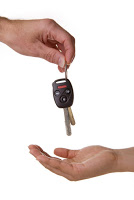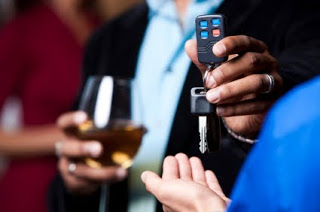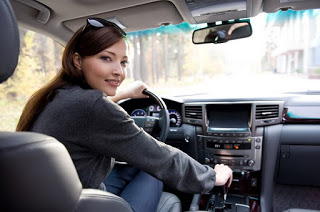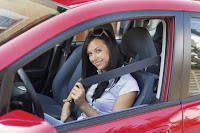Category Archive: Parents

Study Shows Teens with Their Own Car Have More Crashes
February 16, 2012
Two studies published in 2009 showed that teens who had to share a car and whose parents who were involved in their driving in a supportive way were far less likely to be involved in a crash or to engage in risky driving behaviors.
The studies, conducted by Children’s Hospital of Philadelphia (CHOP) and State Farm Insurance, were published in the October 2009 issue of Pediatrics. According to a news release by State Farm Insurance, the studies were based on a National Young Driver Survey of more than 5,500 teenagers in grades 9 through 11.
The first study showed that “teens who said their parents set clear rules, paid attention to where they were going and whom they were with, and did so in a supportive way were:
- half as likely to crash
- twice as likely to wear seat belts
- 71 percent less likely to drive while intoxicated
- 30 percent less likely to use a cell phone while driving
These findings are compared to teens who said their parents were less involved.”
The second study looked at teens who either owned their own car or had easy, unrestricted access to a car were twice as likely to be involved in a crash. The study showed that almost 75% of teen drivers owned or had unrestricted access to a car. 25% of teens who were the main driver of a car reported having been involved in a collision compared to just 10% of those who had to borrow a car.
On a basic level it makes sense; a teen that has to borrow a car faces the wrath of the owner if that car is damaged or destroyed. Teens who own their own car don’t feel that sense of responsibility to protect someone else’s property from harm.
These studies show the critical importance of parental involvement in a teen’s driving environment and add to data that shows Graduated Drivers Licenses for teens work to create a safer driving environment for teens.
Car crashes are the main cause of death for teenagers in the United States. According to the National Highway Traffic Safety Administration (NHTSA), teens are involved in three times as many fatal traffic crashes as all other drivers.
NHTSA figures for 2009 show:
- Traffic crashes are the leading cause of death for 15 to 20 year olds.
- 5,148 15- to 20-year-old drivers were involved in fatal crashes.
- 2,336 15- to 20-year-old drivers were killed.
- 196,000 15- to 20-year-olds were injured in motor vehicle crashes.
- 15 to 20 year old drivers make up 6.4% of the licensed drivers in the US but they account for 11% of the fatal crashes.
Many parents, especially in those households where both parents work, look forward to the day when they no longer have to transport their teen to various activities. However parents should strongly resist the urge to buy a car for the sole use of the teen; at least for the first year. According to data from the Insurance Institute for Highway Safety (IIHS) the most dangerous time for teens is the first year after receiving their driver’s license. The IIHS states that “the crash rate per mile driven is twice as high for 16 year-olds as it is for 18-19 year-olds.”
“Our data show that one of the safest decisions families can make is for parents to control access to the keys for at least the first 6 to 12 months after a teen gets his license,” says Flaura Koplin Winston, MD, PhD, study co-author and scientific director of the Center for Injury Research and Prevention at CHOP. “Our data show an alarming trend – almost three-quarters of teens have easy access to a car. Compared to teens that have to share a car, these teens are twice as likely to crash and more likely to speed and to use a cell phone while driving. When teens have to ask for the keys before taking the car, it naturally creates the opportunity for parents to have conversations with their teens about where they are going, who they will be with, and to review the house rules about driving with passengers, wearing seat belts, using cell phones, and which routes are safe.”
A dialogue should be started with the teen before they receive their learner’s license and an effective tool for setting up those rules and boundaries is the Parent-Teen Driving Contract. When parents and teens both agree on what the rules should be, the teen is more likely to take ownership of that decision.

Social Host Liability Laws
December 29, 2011
As the New Year approaches and parties are being planned, hosts should be aware of their liabilities and responsibilities when it comes to serving alcohol.
Every state has some form of a little known law known as Social Host Liability Laws. Most of these laws are sub-chapters of “Dram Shop” laws. Dram shop laws are those laws that set out the responsibilities and liabilities for businesses such as bars and restaurants that regularly serve alcohol. Social Host laws however refer to the responsibilities and liabilities for a home owner or party host.
In most states the Social Host laws refer primarily to a homeowner who knowingly serves alcohol to a minor. While most responsible adults would never consider serving alcohol to a minor, a surprising number of adults either actively serve alcohol at parties attended by minors or turn a blind eye when their teens are hosting a party where alcohol is served. A recent article in the Brockton, MA Enterprise cited a survey conducted by Hingham High School where students were asked if they had attended parties where parents allowed teens to drink. More than 25 percent of freshmen and juniors at the school answered that they had attended such parties – an increase of 30 percent since 2008. A similar study at seven schools in Concord MA revealed that 27 percent of the students had attended parties where parents allowed teens to drink.
Social Host laws also hold parents criminally responsible even if they were unaware that the teens had sneaked the alcohol in. A Stanford professor who recently hosted a party for his son and friends specifically stated that no alcohol was allowed. Apparently, without the professor’s knowledge, some of the teens brought alcohol to the party and police showed up around 11:00 pm to investigate. The professor was charged with 44 counts of contributing to the delinquency of a minor – one for each teen at the party.
While there are separate laws concerning supplying alcohol to a minor, Social Host laws go further and hold the host both criminally and civilly liable if one of their guests causes injury to a third party. Some Social Host laws also prohibit serving alcohol to someone – teen or adult – who has a known drinking problem. Other states hold the host liable if they provide keys to an intoxicated adult who went on to injure a third party in a collision.
Parents who have the idea that they would rather have their kids drinking “safely” at home rather than out on the street need to remember their responsibility to be “Be A Parent, Not A Pal.” For hosts of adults, they should also be aware of their responsibilities and remember that old adage: “Friends Don”t Let Friends Drive Drunk.”To prevent one of your guests from leaving a party while intoxicated, a host has several options:
- Take the car keys from your guests as they enter and plan on them spending the night.
- Call a cab for your guests.
- Be aware of services provided by cab and towing companies or public transportation agencies that provide free or low cost rides on New Year’s Eve.
- Be a really good host, remain sober and be the designated driver for your guests.
For more information on Social Host laws in your state, visit: http://www.socialhostliability.org/
Have a safe and a happy New Year.

Effectiveness Of In-Vehicle Monitoring Systems For Teen Drivers
November 9, 2011
The Insurance Institute for Highway Safety (IIHS) conducted an interesting experiment in 2009 that tested the effectiveness of various in-vehicle monitoring systems on teen drivers. The study monitored the driving habits of 84 teen drivers with different types of in-vehicle technology to determine which ones had the greatest effect on both the teen drivers and their parents.
IIHS installed their own monitoring equipment in the study vehicles that recorded when drivers braked sharply or accelerated suddenly, didn’t use belts, and exceeded speed limits. The monitors used GPS and a satellite modem to transmit the data to a central processing facility and the data was made available for parents to review. In addition to its own monitoring systems, IIHS also installed different types of in-vehicle monitoring that are commercially available to parents of teen drivers. The 84 subjects were randomly assigned into four groups:
“Drivers in groups 1 and 2 heard audible alerts for risky maneuvers. A short, low-pitched buzz sounded for sudden braking and acceleration. A continuous low-pitched buzz sounded when the belt wasn’t buckled and stopped only when it was fastened. Speeding triggered a single beep at 2.5 mph over the posted limit, followed by continuous beeps at increasing pitch and frequency when the teenage drivers exceeded the limit by more than 10 mph.” For drivers in group 1, the information was immediately recorded and transmitted to the parents for review. The drivers in group 2 had the opportunity to correct their behavior and, if corrected within 20 seconds, prevent a report from being sent to their parents.
There were no in-vehicle alerts for drivers in group 3, just website notification. Group 4, the control group, was monitored but had no alerts or web notification.
The different types of monitoring systems included:
- Basic systems: CarChip Pro – http://www.carchip.com/Products/8226.asp, CarChipPro is essentially a black box that plugs into the car’s diagnostic recorder. The system can record speed, mileage, and other data. Once the information is downloaded, it provides parents with a history of the teen’s driving. The system may also be set to turn into an alarm if certain speeds are reached or if the driver is braking too hard. The system is a tool to help discuss a teen’s driving habits by allowing parents to show them the facts, and how to correct their driving behavior.
- GPS-based systems: Inthinc’s Tiwi – http://www.inthinc.com/products/tiwifamily This system monitors drivers in real-time by providing in-vehicle, verbal feedback to the driver when they are speeding, not wearing their seat belt or driving aggressively. Also, parents can be notified immediately of unsafe driving behavior (through text, voicemail or email) and all info is reported through an Internet-based portal for later review and discussion between parent and teen. This system gives teens a chance to correct their behavior before their parents are notified.
- Video systems: DriveCam: Teen Safe Driver Program package – http://www.drivecam.com/, This in-car camera system records “risky driving behavior” and sends them to DriveCam for third-party assessment of a teen driver’s skills. The reports are then sent to parents, who can discuss the driving behavior with their teen.
- Smart keys: MyKey – http://media.ford.com/article_display.cfm?article_id=29172, First seen on the 2010 Ford Focus, the MyKey system is designed to help parents set certain limitations on their Ford vehicles for when their teens are driving. With the configurable key, this system is designed for parents who share their cars with teen drivers. Ford has announced that this technology will be available in all Ford vehicles beginning in 2012. The key features are:
- Do Not Disturb, prevents use of cell phone and texting while the car is in motion.
- Speed Control, limiting the top speed of the Ford vehicle to 80 mph.
- Volume control, which allows parents to set a maximum volume level for the car’s radio.
- Beltminder, an alarm system that mutes the radio and plays a chime every 6 seconds, every minute or every 5 minutes when the seatbelt is unbuckled.
- Fuel reminder: alerts the teen that they need to refuel, when fuel is low.
The results of the study were as follows:
- Seat belts – Seat belt use was already at a 94% level when the study began but increased among all four groups when the drivers were faced with a continuous buzzing or chiming noise. This has been found to be effective among all age groups.
- Stops and starts – Sudden braking and rapid starts can indicate aggressive driving or inattention to the driving environment. Sudden stops and starts fell in all groups relative to the control group but was especially significant group 1 with immediate web notification to their parents. The effects were even greater among those whose parents received periodic report cards.
- Speeding – Speeding was the most prevalent risky behavior noted among all groups. Speeding up to ten mph over the posted speed limit fell among the groups with alerts in their vehicles but then started to rise over time. Speeding was only significantly reduced among the groups whose parents were notified or those who had a chance to correct the problem before parental notification.
- All risky behaviors – Risky behaviors declined most among the two groups with parental notification but were most noticeable among group 2, the ones who had a chance to correct their behavior before parental notification. Risky behavior was somewhat higher in group 1, apparently because it was too late to correct the behavior and their parents were going to be notified anyway.
Parents will want to consider the results of this study when choosing an in-vehicle monitoring device for their teen driver.
How’s My Driving Decals
July 14, 2011
You’ve seen one of them: decals that ask the question: “How’s my Driving?” These used to be more common for trucks, cabs or other public service vehicles — now, several services have popped up that have expanded on the functionality of these decals into letting parents know if their teen drivers are doing a good job of driving.
Here are some of those services:
Teen Road Angel (www.teenroadangel.com) – From their name itself, they are immediately announcing that their focus is towards teens. Upon availing of a membership ($40 annual fees, $20 for additional driver), a specialized decal is created for the driver. When someone calls the number on the decal, a notification is sent to the parent via email, text message or voice mail. They are currently working out deals with insurance companies to hopefully provide discounts for availing of their decals.
JustReportIt (www.justreportit.com) – JustReportIt, the cheapest service in this list comes at only $20 for the first year, and $10 for each renewal. They have achieved this price point by requiring the report entry online-only. There is no special number to call, but relies on people to take note the specialized code assigned to the decal and have them enter it on the report page on their site. While not specifically focused for teens, businesses may also avail of their services and even get their decal customized with a company logo.

Top 5 Hints for Passing the DMV Road Test
July 8, 2011
Picture the DMV road test: new driver in the driver’s seat, driving examiner-with-clipboard-in-hand sitting beside him in the passenger’s seat, giving instructions and with an ever-so-tight grip on a pen, taking notes. The driving exam can be grueling for new drivers who are worried about passing/failing — in other words, anxiety may become a factor in passing the driving road test.
Here are the top 5 hints for passing the driving road test:
1. Get lots of practice during your learner’s permit period. In most states, there is a required waiting period from getting a permit or intermediate license before a new driver is allowed to take the road test. This is essentially the state giving the new driver a chance to practice all the skills needed to pass the road test.
2. Obey signs/signals and avoid hitting the cones/curbs. Just because the driving examiner is writing notes on the examination form, that doesn’t mean that new driver has made a mistake. The examiner has to write down the good things as well as the bad. Minor mistakes are allowed but, if those minor mistakes add up to 30 points, you will fail the exam. There are several things that will cause you to automatically fail the exam. Failure to obey traffic signals/signs or hitting the cones/curbs while parking or conducting the three-point-turn are the most common reasons for an automatic failure. For the stopping part, there’s this 4-second-stop rule: to be sure that the car is in a complete halt, step down on the brakes and count to 4 to make sure that the car is totally stopped. For the parking segments, ask a family member (who is a valid license holder) to show you exactly how to park the right way and then practice it – – a lot! Practice the three-point-turn on a narrow street. Practice makes perfect.
3. Follow the examiner’s directions, while demonstrating the ability to make the right decisions. The driving examiner will not ask you any trick questions nor will he or she ask you to do anything that is illegal. Driving is tricky enough all by itself so they don’t have to try to trick you. The examiner will give you straight, simple instructions. Don’t look for the hidden meaning in the instructions; just do as he/she says. If you truly don’t understand the instruction, ask for clarification. It is better to ask than to try to guess and make a mistake. The stupid questions are the ones that don’t get asked.
4. Obey the state’s driving law. This one’s pretty simple, even with varying laws between states, there are still driving laws that are common to most. An example would be:
- Properly wearing a seatbelt before starting the vehicle.
- Properly yielding to other traffic when changing lanes.
- Properly giving a turn signal when turning, changing lanes, or turning into or backing out of a parking space
- Safe driving around school buses and school zones. (There will usually be signs to follow.)
- Knowing the meaning of a Yield sign. Slow and look for other traffic or pedestrians crossing your path and be prepared to stop if necessary. If the way is clear, keep going.
- Stop for pedestrians in a crosswalk.
- Don’t follow too close, maintain a two to three-second following distance.
5. Make sure you have all of the documents that will be needed. In order to take the road test, you will need a current vehicle registration slip that matches the dates on your tags. You will also need a current proof of insurance form. Both of these documents should be in the vehicle at all times. For proof of your ID to get a license, you will need a minimum of the following (check with your local DMV for a complete list):
- Birth Certificate with raised seal (or current passport)
- Social Security Card
- More than one proof of address, such as your parent’s electric or home insurance bills.
You will also need:
- A form signed by your parent of guardian showing you have received the necessary number of driving instruction hours for both day and night driving.
- Your parent’s written permission to receive a license (if under the age of 18).
- A certificate showing you have completed any state required driver education.
Master the Driving Maneuvers for the Road Test with a “Behind-the-Wheel” Online Simulator Course
